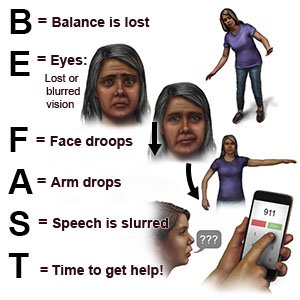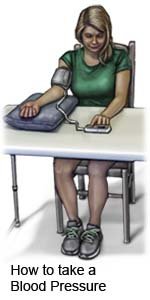Brainstem Infarction
Medically reviewed by Drugs.com. Last updated on Aug 4, 2025.
A brainstem infarction (BSI) is a stroke that happens when blood cannot flow to your brainstem. When oxygen cannot get to an area of the brain, tissue in that area may get damaged. Your brainstem controls your ability to speak, hear, and swallow. It also controls your breathing, heartbeat, blood pressure, balance, and eye movements.
DISCHARGE INSTRUCTIONS:
Call your local emergency number (911 in the US) or have someone call if:
- You have any of the following signs of a stroke:
- Numbness or drooping on one side of your face
- Weakness in an arm or leg
- Confusion or difficulty speaking
- Dizziness, a severe headache, or vision loss

- You have a seizure.
- You suddenly feel dizzy, lightheaded, and have shortness of breath.
- You have chest pain. You may have more pain when you take a deep breath or cough. You may cough up blood.
Seek care immediately if:
- Your arm or leg feels warm, tender, and painful. It may look swollen and red.
Call your doctor or neurologist if:
- Your blood pressure is higher or lower than you were told it should be.
- You have skin tears, or sores on your heels, head, or buttocks from lying in bed.
- You have bowel movement problems.
- You have questions or concerns about your condition or care.
Warning signs of a stroke:
The words BE FAST can help you remember and recognize warning signs of a stroke:
- B = Balance: Sudden loss of balance
- E = Eyes: Loss of vision in one or both eyes
- F = Face: Face droops on one side
- A = Arms: Arm drops when both arms are raised
- S = Speech: Speech is slurred or sounds different
- T = Time: Time to get help immediately
 |
Related medications
Treatment options
The following list of medications are related to or used in the treatment of this condition.
Medicines:
You may need any of the following:
- Antiplatelets , such as aspirin, help prevent blood clots. Take your antiplatelet medicine exactly as directed. These medicines make it more likely for you to bleed or bruise. If you are told to take aspirin, do not take acetaminophen or ibuprofen instead.
- Blood thinners help prevent blood clots. Clots can cause strokes, heart attacks, and death. Many types of blood thinners are available. Your healthcare provider will give you specific instructions for the type you are given. The following are general safety guidelines to follow while you are taking a blood thinner:
- Watch for bleeding and bruising. Watch for bleeding from your gums or nose. Watch for blood in your urine and bowel movements. Use a soft washcloth on your skin, and a soft toothbrush to brush your teeth. This can keep your skin and gums from bleeding. If you shave, use an electric shaver. Do not play contact sports.
- Tell your dentist and other healthcare providers that you take a blood thinner. Wear a bracelet or necklace that says you take this medicine.
- Do not start or stop any other medicines or supplements unless your healthcare provider tells you to. Many medicines and supplements cannot be used with blood thinners.
- Take your blood thinner exactly as prescribed by your healthcare provider. Do not skip a dose or take less than prescribed. Tell your provider right away if you forget to take your blood thinner, or if you take too much.
- Other medicines may be given to treat diabetes, high cholesterol, depression, or to prevent seizures. You may also need medicine to keep your blood pressure at a certain level if it is too high or too low.
- Take your medicine as directed. Contact your healthcare provider if you think your medicine is not helping or if you have side effects. Tell your provider if you are allergic to any medicine. Keep a list of the medicines, vitamins, and herbs you take. Include the amounts, and when and why you take them. Bring the list or the pill bottles to follow-up visits. Carry your medicine list with you in case of an emergency.
Rehabilitation
(rehab) is an important part of treatment. Physical therapists help strengthen your arms, legs, and hands. You may learn exercises to improve your balance and movement to decrease your risk for falling. Occupational therapists teach you new ways to do daily activities, such as getting dressed. A speech therapist helps you relearn or improve your ability to talk and swallow.
What you need to know about depression after a stroke:
Talk to your healthcare provider if you have depression that continues or is getting worse. Your provider may be able to help treat your depression. Your provider can also recommend support groups for you to join. A support group is a place to talk with others who have had a stroke. It may also help to talk to friends and family members about how you are feeling. Tell your family and friends to let your healthcare provider know if they see any signs of depression:
- Extreme sadness
- Avoiding social interaction with family or friends
- A lack of interest in things you once enjoyed
- Irritability
- Trouble sleeping
- Low energy levels
- A change in eating habits or sudden weight gain or loss
Prevent another stroke:
- Manage health conditions that can lead to a stroke. High blood pressure, diabetes, and high cholesterol all increase your risk for stroke. Take your medicines as directed. Do not stop taking these medicines. Follow your healthcare provider's instructions to check your blood pressure and blood sugar levels. Write the numbers down to show your provider.

- Eat healthy foods. What you eat can help prevent or manage high blood pressure, high cholesterol, and diabetes. Eat foods that are low in fat, cholesterol, salt, and sugar. Eat at least 5 servings of fruits and vegetables each day. Include foods that are high in potassium, such as potatoes and bananas.

- Reach or stay at a healthy weight. Weight loss can decrease your blood pressure and your risk for stroke. Ask your healthcare provider what a healthy weight is for you. Your provider can help you create a safe weight-loss plan, if needed. Ask which exercises you should do. You will need to exercise carefully after a stroke so you do not fall.
- Limit or do not drink alcohol, as directed. Men should limit alcohol to 2 drinks per day. Women should limit alcohol to 1 drink per day. A drink of alcohol is 12 ounces of beer, 5 ounces of wine, or 1½ ounces of liquor.
- Do not use street drugs or smoke cigarettes. Your risk for another stroke increases if you use drugs such as cocaine, or you smoke cigarettes. Ask your healthcare provider for information if you need help to quit.
Follow up with your doctor or neurologist as directed:
You may need to come in for regular tests of your brain function. Write down your questions so you remember to ask them during your visits.
For support and more information:
- American Stroke Association
Phone: 1- 888 - 478-7653
Web Address: http://www.stroke.org
© Copyright Merative 2025 Information is for End User's use only and may not be sold, redistributed or otherwise used for commercial purposes.
The above information is an educational aid only. It is not intended as medical advice for individual conditions or treatments. Talk to your doctor, nurse or pharmacist before following any medical regimen to see if it is safe and effective for you.
Learn more about Brainstem Infarction
Treatment options
Care guides
Further information
Always consult your healthcare provider to ensure the information displayed on this page applies to your personal circumstances.
